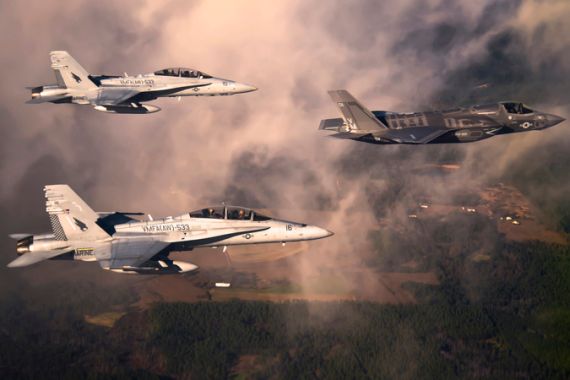Pentagon unveils details of US defence cuts
Strategy announced for absorbing $487bn in defence cuts, including reducing ground forces and slowing weapons purchases.

Pentagon leaders have outlined a plan for absorbing $487bn in defence cuts over the coming decade by shrinking US ground forces, slowing the purchase of a next-generation stealth fighter jet and retiring older planes and ships.
In a bid to pre-empt election-year Republican criticism, Leon Panetta, the US defence secretary, said on Thursday the plan shifts the Pentagon’s focus from the wars in Iraq and Afghanistan to future challenges in Asia, the Middle East and in cyberspace.
Keep reading
list of 4 itemsWhy are nations racing to buy weapons?
Parallel economy: How Russia is defying the West’s boycott
US House approves aid package worth billions for Ukraine, Israel
More special operations forces such as the Navy SEALs who killed Osama bin Laden will be available around the world, he said.
“Our approach was to use this as an opportunity to maintain the strongest military in the world, to not hollow out the force,” he said in a statement prepared for a Pentagon news conference.
Some US legislators were quick to dispute him.
“Taking us back to a pre-9/11 military force structure places our country in grave danger,” said Senator John Cornyn, a Republican and a member of the Senate Armed Services Committee that will hold hearings on the Pentagon budget plan.
Panetta announced that the administration will request a 2013 budget of $525bn, plus another $88bn for operations in Afghanistan. Combined, those totals are about $33bn less than the Pentagon is spending this year.
Panetta said, however, that the Pentagon’s base budget will grow to $567bn in 2017.
At that point, the cumulative budgets over five years would be $259bn less than had been planned before the administration struck a deficit-cutting deal with congress last summer that requires projected defence spending to be reduced by $487bn by 2022.
Army to shrink
Panetta announced that the army would shrink by 80,000 soldiers, from 570,000 today to 490,000 by 2017. That is slightly larger than the army on September 11, 2001.
The Marine Corps would drop from today’s 202,000 to 182,000 – also above the level present during the September 11 attacks on the US.
Panetta said that the air force would retire some older planes, including about two dozen C-5A cargo aircraft and 65 of its oldest C-130 cargo planes.
|
Inside Story Americas examined where the new strategy would leave the US’s military commitments |
The navy would keep a fleet of 11 aircraft carriers but retire seven cruisers earlier than planned. It also would delay purchase of some other ships, including a new Virginia-class submarine.
Purchase of F-35 stealth fighter jets, to be fielded by the air force, navy and Marine Corps, would be slowed.
Current plans for building a new generation of submarines that carry long-range nuclear missiles would be delayed by two years, while the current fleet of nuclear-capable bombers and land-based nuclear missiles would be left unchanged.
Military pay raises will remain on track until 2015, Panetta said, when the pace of increase will be slowed by an undetermined amount.
President Barack Obama will ask congress to approve a new round of domestic base closures, although the timing of this was left vague and there is little chance that legislators would agree to this in a presidential election year.
The defence spending plan is scheduled to be submitted to congress as part of the administration’s full 2013 budget on February 13.
Prominent in the Obama plan is a renewed focus on Asia, where China’s rapid military modernisation has raised worry in Washington and rattled US allies.
Panetta also has made clear the administration will resist any effort to shrink the navy’s fleet of aircraft carriers.
He said last weekend while on board the fleet’s oldest carrier, the USS Enterprise, that keeping 11 of the warships is a “long-term commitment” that Obama believes is important to keeping the peace.
“Our view is that the carriers, because of their presence, because of the power they represent, are a very important part of our ability to maintain power projection both in the Pacific and in the Middle East,” he said.
Presidential contest
The defence budget is being reshaped in the midst of a presidential contest in which Obama seeks to portray himself as a forward-looking commander in chief focusing on new security threats.
Republicans want to cast him as weak on defence.
Obama has highlighted his national security successes – the killing of Osama bin Laden, the death of senior al-Qaeda leaders and the demise of Libya’s Muammar Gaddafi – to counter Republican criticism.
He also has emphasised the completion of the US troop withdrawal from Iraq and the start of a drawdown in Afghanistan as turning points that offer new opportunities to scale back defence spending.
But several congressional Republicans see a political opening in challenging the reductions in projected military spending that the party and Obama agreed to last summer as part of a deal to raise the nation’s borrowing authority.
They have echoed Obama’s potential presidential rivals Mitt Romney, Newt Gingrich and Rick Santorum, who plead for fiscal austerity but contend that sizable cuts would gut the military.